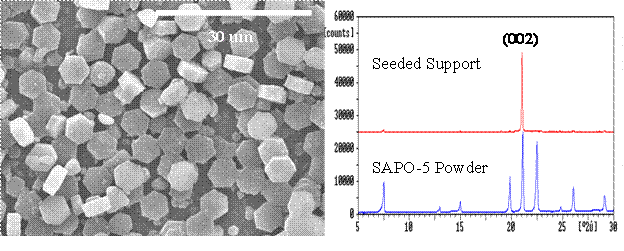Reports: AC10
46427-AC10 Carbon Nanotube Membranes by Templated Growth in Oriented Molecular Sieve Films
The ability of a membrane to exhibit high fluxes of permeating molecules as well as high selectivity in gas, vapor, or liquid separations would prove to be a major breakthrough with extensive cost and energy savings. Simulations and experiments using carbon nanotube hosts have shown incredibly high fluxes of small molecules. Our recent success in fabricating highly-oriented, well-intergrown, and continuous aluminophosphate (AlPO4) molecular sieve films are of interest because they can serve as highly selective membranes. The goal is to grow templated, submicron-thick, densely-packed, sub-nanometer diameter carbon nanotubes using the interior porous structure of AlPO4-5 or cobalt-substituted CoAPO-5 molecular sieve films. The dual ability to selectively separate permeating molecules at high fluxes may result in a novel membrane with extraordinary performance.
AlPO4-5 structures consist of one-dimensional straight channels with 7.3Å pore openings along the crystallographic c-axis. For film growth, crystal alignment relative to the substrate based on the preferred c-orientation is necessary for permeating molecules to easily pass, as well as for densely-packed and aligned templated carbon nanotubes in the crystal pores. Past research efforts in our group explored synthesis conditions for AlPO4-5 and CoAPO-5 film growth on silicon substrates, concluding that seeded growth involving substrate functionalization was needed in order to overcome deficiencies such as poor coverage or random crystal orientation. Additional synthesis conditions such as crystallization temperature and time were manipulated in order to control nucleation and growth. The method must be successfully transferred to growth on a porous support in order to move toward membrane applications such as selective separation of similarly-sized molecules.
Porous, cylindrical α-Al2O3 supports were chosen for CoAPO-5 film growth. Columnar CoAPO-5 seed crystals were broken through sonication in dilute hydrochloric acid solution. Analogous to seed deposition on silicon substrates, the alumina supports were first functionalized by a silane coupling agent (3-chloropropyltrimethoxysilane) and subsequently sonicated between two glass slides in a predetermined concentration of broken CoAPO-5 seed crystals in dry toluene. Two hydrothermal growths of differing precursor gel composition were utilized in order to obtain a continuous, highly-oriented membrane as seen in Figure 1. Secondary growth resulted in oriented crystals that were not intergrown. By varying certain experimental parameters, crystal growth was dominated in the plane parallel to the support, retaining the preferred orientation as well as resulting in crystal intergrowth and excellent coverage.
Figure 1. Scanning electron microscopy (SEM) images following secondary growth (left) and tertiary growth (right) of a CoAPO membrane on a porous alumina support. Following tertiary growth, the membrane is highly oriented and well-intergrown.
In addition to cobalt-substituted CoAPO-5, silicon-substituted SAPO-5 has been reported useful as a catalytic host for the templated growth of carbon nanotubes. An alternative technique to sonication-assisted covalent attachment was employed to deposit crystal seeds to a silicon wafer support, shown in Figure 2.
Figure 2. Schematic representation of the rubbing technique utilized for SAPO-5 seed particle deposition. The center SEM image is of the hexagonal, plate-like SAPO-5 crystals. The scale bar corresponds to 4μm.
Here, a
silicon wafer was spin-coated with a solution of polyethyleneimine
(
Figure 3. SEM image (left) and corresponding XRD pattern (right) of SAPO-5 powder seed deposition on a silicon substrate using an electrostatic interaction-based rubbing technique. The diffraction pattern reveals that the seed crystals are oriented along the crystallographic c-axis.
Future effort
will be placed on optimizing the seed support procedure, including rubbing time
and concentration of The existence of debilitating defects
present as cracks throughout the membrane occurring as a result of post-synthesis
thermal processes limits their effectiveness for successful selective
separations. Recently, our group has
demonstrated that rapid thermal processing (RTP) of c-oriented siliceous ZSM-5
membranes on alumina disk and stainless steel supports was shown to improve the
separation performance for aromatic and linear versus branched hydrocarbon
isomers by strengthening grain bonding at the grain boundaries. Introductory RTP treatment research has been
performed using CoAPO-5 membranes grown on alumina disks. Considerable effort will focus on preparing high-quality,
defect-free films to serve as highly selective membranes and as catalytic
supports for subsequent templated carbon nanotube growth. This work is performed in collaboration with
Professor Avelino Corma of
the Instituto de Tecnología
Química and Dr. George Karanikolos
of the







